Population growth
A few years before the outbreak of World War I, there began an explosion of population and house building in the Canterbury Municipality which continued until the Great Depression at the beginning of the 1930s and then began again after World War II.
Although the opening of the railway line from Sydenham to Belmore in 1895 began a new phase in the history of the district, a depression in the 1890s meant that development was slow. From about 1906, growth began and, when the railway was extended from Belmore to Bankstown in 1909, this added further opportunity for land subdivisions and building.
A 1914 newspaper article headed “Expanding Sydney – Growth of Bankstown Line” (Daily Telegraph 10th December 1914) refers to the rapid growth within a few years along the railway line from Hurlstone Park to Bankstown. “Five years ago in the whole area … there were only about 1300 houses, with an approximate population of 6000. To-day, however, so rapid has been the expansion in the meantime, the municipality has no fewer than 5000 dwellings and business premises and a population of 24,000.” (The latter figures are slightly exaggerated.) The article refers to Campsie as a “baby” as far as suburbs go, but with “a business section of substantial dimensions, and a closely, but not uncomfortably, settled residential area”.
Whereas the 1901 Census showed that Canterbury Municipality had a population of 4,226, this had grown quickly to 11,335 by the 1911 Census. However, the growth in the next ten years was remarkable, reaching 37,639 in the 1921 Census.
In the same ten years from 1911 to 1921, the number of buildings in Canterbury rose from 2,329 to 8,225.
Although only estimates, the annual growth is shown by the population estimates in the Sands Directories between 1912 and 1920:
- 1912 12,000+
- 1913 16,000+
- 1914 and 1915 19,000+
- 1916-1919 30,000+
- 1920 35,350
More population meant more houses, shops, schools and classrooms, churches and service buildings such as fire stations. The men who enlisted during World War I left a rapidly growing district and came back to find even more growth in their absence.
War begins
Australian Red Cross was formed on 11th August 1914 after Lady Helen Munro-Ferguson, wife of the Governor-General of Australia and one-time member of British Red Cross, sought and received permission to establish an Australian arm of British Red Cross. Within days, Red Cross branches sprang up in NSW, including Campsie. Members volunteered to pack and distribute comfort packs to make life a little easier for the troops. Campsie branch held stalls and street processions to raise funds and purchased clothing, knitted socks, sent books, magazines and food, and made donations to the Belgian Relief Fund and the NSW Division of the Red Cross.
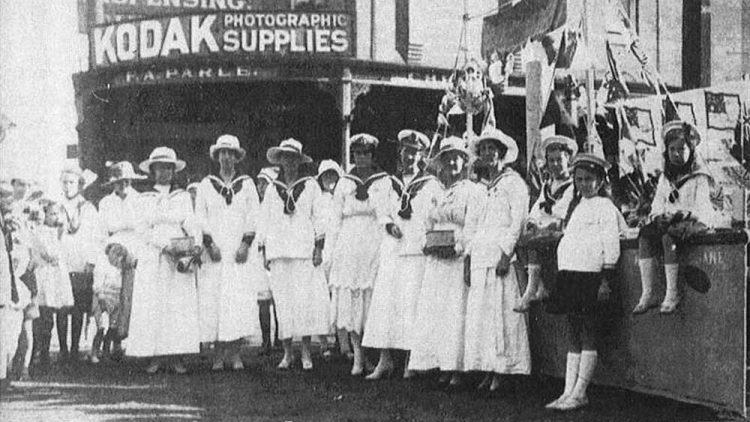
Sailor girls fund raising in Beamish Street, Campsie in 1915. (Canterbury City Library)
The first mention of the war in the minutes of Canterbury Council is correspondence from the Belgian Clothing Relief Society wishing to obtain new and second-hand clothing for Belgians made destitute by the war. Council offered the Town Hall as a depot to receive clothing and a carrier offered to deliver any donations to the Belgian Consulate.
During the war, the Council considered a range of matters related to the war, as well as dealing with the usual day-to-day happenings. It considered suggestions that all males bom in Germany, Austria and Turkey of military age should be interned for the duration of the war and that no German or Austrian subjects be employed by any Council in NSW; there were many requests for permission for fetes and collections to be made for sick and wounded soldiers and other charities associated with the war; in 1915, it received a letter from the NSW Recruiting Campaign thanking the Council and those associated with it for splendid services rendered to the recruiting movement; it decided in 1916 to erect a commemorative board at the Town Hall for the names of those in the district who had enlisted; in response to a request from the Hon State Organiser of the Returned Soldiers Association of NSW to participate in the due celebration of “Anzac Day” on 25th April 1916 [that is, on the first anniversary of the landing on Gallipoli], it replied that it would “do its very utmost to celebrate the day in a fitting manner’; it agreed to a request from the Premier of NSW for a public meeting to be held on 4th August 1916 so that the following resolution could be moved: “That on this Second Anniversary of the declaration of a righteous war, this meeting of citizens of Canterbury records once more its inflexible determination to continue to a victorious end the struggle to maintain that ideal of liberty and justice which is the common and sacred cause of the Allies.”; it considered proposals by the State War Council for reinstatement in civilian life of returned soldiers unfit for further service including unpaid training by Councils in clerical, accountancy and administrative work; in 1916 the person subdividing 67 acres at Belfield offered two allotments to erect homes for returned soldiers or widows of soldiers, but the Council asked that the kind offer be changed to a 20% reduction in the cost of each allotment so that the benefit could be spread over a greater number of applicants; as late as June 1918, there was a suggestion that “Strong Posts” should be formed for departing and returning troops (it was the Campsie Women’s Strong Post which financed the Campsie Clock Tower Memorial in 1932).
Street names changed
Soon after the outbreak of war, there quickly developed strong anti-German feeling, particularly because of German violation of Belgian neutrality and newspaper items referring to German treachery, brutality, cruelty and wanton destruction, Prussian bullying and “Germany’s return to the Dark Ages”.
At its meeting of 30th November 1914, Canterbury Municipal Council considered a request from the Canterbury Political Labor League “that the German names of ‘Kaiser’, ‘Bismarck’, and ‘Deutshland’ streets be changed, as the names are distasteful to all loyal subjects of the British Empire”. It asked “the Council to remove these names as the people of Canterbury did not want any name suggestive of German ‘culture’ ”.
On the recommendation of local residents, new names were adopted. Kaiser Street was re-named Mons Street to commemorate British gallantry in the battle near the Belgian town of Mons on 23rd August 1914. Bismarck Street became Cressy in memory of the heroism of the British sailors on HMS Cressy, one of three British cruisers sunk by German submarines off the Hook of Holland in 75 minutes on 22nd September 1914 with the loss of 1460 lives; HMS Cressy had gone to pick up survivors of the other two when it was itself sunk. Deutchland Street was changed to Onslow after Captain Arthur William Macarthur Onslow, an Australian serving with the British forces who was killed in action near Ypres, Belgium, in early November 1914. The Council chose the name “as a memorial to a brave officer who had fallen in the Empire’s cause”.
At the request of the Punchbowl Progress Association, Hamburger Street was changed, the name selected being Victoria Road. Mathias Hamburger had owned the land since 1885, and Private Clair William Hamburger, a farmer of Canary Road, Lakemba, who was probably his grandson, enlisted in 1914. He was wounded in France in 1916, and returned to Australia in 1919.
The Westheider family had been in the Canterbury district at least since 1895, but the Punchbowl Progress Association asked the Council to alter the name of Westheider Avenue. Charlescot (now Charlescotte) Avenue was selected in 1916. Gunner Thomas Westheider (who had enlisted as Thomas West in May 1916) was killed in action in France in 1917, and Private Charles Oliver Westheider of Belmore Road, Punchbowl, enlisted in April 1916, returning to Australia in 1919.
Other members of families with German-sounding names served overseas. At least six members of the Brandt family served in the A.I.F.; most of them joined up under the more English-sounding name of Brand. They were probably grandsons of John Brandt, who settled in Lakemba in 1864.
Names of new streets
Land in Punchbowl was subdivided in October 1914, with a street named Belgium Street. The street was probably named to exploit the patriotic fervour of the early months of World War I. In the first days of the war, Germany had invaded tiny Belgium, evoking great sympathy for that country and the Belgian people made refugees of war.
With the Gallipoli campaign in full swing in October 1915, Kitchener and Hamilton Streets in Earlwood were no doubt named after Field Marshal Lord Kitchener, the British Secretary of State for War who ordered the attack on the Gallipoli Peninsula, and General Sir Ian Hamilton, who commanded the expeditionary force in the Gallipoli assault.
The patriotic name of Anzac was given to a street in a new subdivision in Canterbury in January 1916.
Farewell functions
Many of the men who enlisted were given farewell parties by family and friends. Sometimes these were intimate affairs at home, sometimes the whole neighbourhood would hire a hall and there would be speeches and presentations. Typical of the parties was one given for five Undercliffe men in February 1916 at the Avon Tea Gardens in Homer Street, near the tram terminus. Recruiting Sergeant Major Forbes, Driver Cotterell and Privates Hoskins, McKinlay and Carpenter were entertained by the residents of Undercliffe, and each was made a presentation by Mr G. Cann MLA, the local Member of Parliament, on behalf of the residents. George Cann enlisted within a few weeks of this event, and was himself entertained by the members of the Campsie Branch of the Political Labor League at the Kia-Ora Hall, Dryden Street, Campsie. He was presented with a silver wrist watch, his brother, also a politician, promised to look after his electorate, and McLeod’s Orchestra played several musical selections. The Kia-Ora Hall was a popular venue: in 1917, the fifteen year old Ossory Arthur Fitzpatrick of the 1st Pioneer Battalion had his farewell there as well. When William Herbert Hocking built bis large home, “Linga-Longa” in Bayview Avenue, Undercliffe, he also offered it for parties for local men.
Goods railway line
Early in the twentieth century, the only track for goods trains to and from Darling Harbour was on the main suburban railway lines through Redfern. By 1908, passenger and goods traffic had grown so much that restrictions prohibiting the movement of goods trains in peak hours were in place. This made it very difficult to operate efficiently.
A separate Metropolitan Goods Line from Flemington to Glebe Island and Darling Harbour via Enfield, Campsie and Dulwich Hill was approved in 1910. Construction began in 1911 and the first section to open was between Flemington and Campsie in April 1916. The line opened through to Glebe Island a few months later and was extended to Darling Harbour in 1922.
Homes for returned soldiers
The first home for a wounded soldier erected in the district by the Voluntary Workers Association was in Wileys Avenue [now King Georges Road] Lakemba in 1916. The subscription for membership of the Association was eight hours voluntary labour or payment of ten shillings by other members.
In March 1917, the assistance of the Voluntary Workers Association was sought to help a returned Anzac who was permanently disabled and had a wife and two children. Out of his deferred pay, he had bought a block of land at Undercliffe, and carpenters, painters, plumbers and bricklayers were asked to assist at weekends until the house at Undercliffe was completed.
Council waived the fee for a building to be erected by the Voluntary Workers Association.
Many other such houses were built in the Canterbury area, including Campsie and Lakemba, and throughout Australia.
Conscription
The people of Canterbury took an active interest in the 1916 Referendum on Conscription, that is for compulsory military service overseas with the previously volunteer Australian Imperial Force (A1F).
In September 1916, Canterbury Council aldermen adopted a Mayoral Minute that they “unhesitatingly place ourselves behind [Prime Minister Hughes] in his patriotic efforts to fill the gaps in the ranks of the Australian forces”.
Public meetings for the “Yes” and the “No” cases were held throughout the district, at Hurlstone Park tram terminus, Belmore Station, Campsie Picture Palace and the Lakemba picture show.
Speakers against conscription included JH Catts MHR, the organiser of the “No” campaign, and Mr W Bridgement of Campsie, whose son was awarded a Military Medal for bravery.
At the Referendum in October 1916, Ashfield, Burwood and Dulwich Hill voted in favour of conscription. In Arncliffe and Bexley, the numbers were almost evenly divided. But in Canterbury, Belmore, Marrickville, Tempe and Bankstown, the people voted against conscription Nationwide, conscription was rejected.
Conscription was again rejected in a second referendum in Australia in December 1917.
In 1918, Council supported a suggestion by Glebe Council that the Federal Government immediately call up all male citizens between the ages of 18 and 60 for training for home defence, such training to be done on Saturday afternoons and at least one night a week.
Armistice Day
A meeting of Canterbury Council was in progress on the evening of 11th November 1918 when, as the Council Minutes record:
The Town Clerk informed the Mayor that the Sun Office had advised that an official announcement had been made of the signing of the Armistice.
The Mayor adjourned the meeting for a short period and addressed the Council on the good news and the great achievement of the Allies, ensuring he hoped, a permanent peace among all peoples of every nation.
The National Anthem was enthusiastically sung, and hearty cheers given for the Empire and Allies.
The Meeting then proceeded.
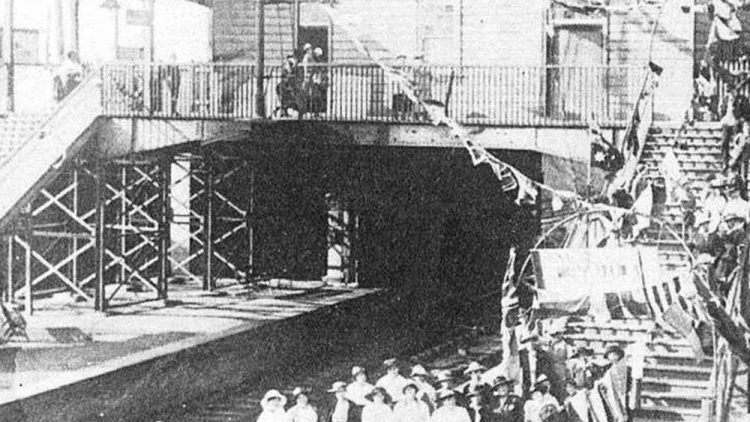
Welcome to returning soldiers at Campsie Railway Station in 1919. (Canterbury City Library)
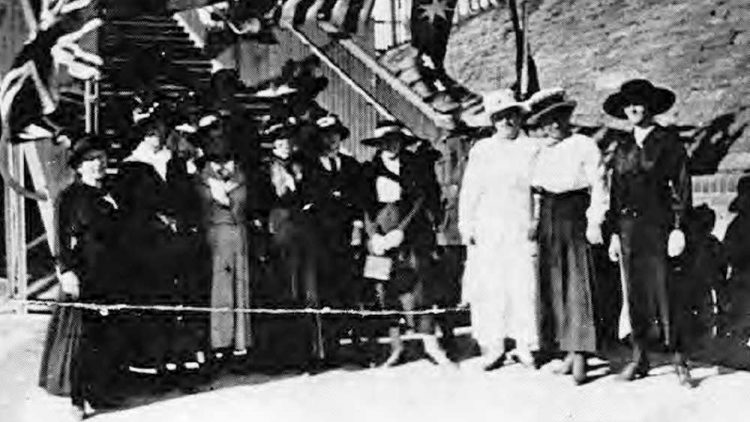
Ladies of the Campsie Strong Post at Campsie Railway Station, ready to welcome home returning soldiers. (Canterbury City Library)
It must have been the next day when pupils of Campsie Public School who were being taught in the Presbyterian and Anglican church halls were each given the opportunity to ring the church bells to spread the joy and the relief the community felt That night, there were great festivities in Beamish Street, with bands playing and dancing in the street, with a spotlight from the Palace Pictures shining on the crowd.
“Welcome Home” functions
From 1915 onwards, but particularly in 1919 and 1920, there were joyous “Welcome Home” activities for returned servicemen.
Many returning soldiers were welcomed at the various railway stations by friends and ladies committee members. School children were often present.
Social evenings for groups of the men were organised by such bodies as the West Ward Progress Association, the Belmore Progress Association, the Canterbury Soldiers Comfort Fund, the Hurlstone Park Soldiers and Sailors Welfare Association, the Canterbury Strong Post and the Campsie Strong Post. Venues included the Belmore Drill Hall, the Canterbury Town Hall, the Hurlstone Hall in Duntroon Street, Hurlstone Park, the Picture Palace opposite the St George Hotel and the “Kia-Ora” Hall at Campsie.
Functions for individuals were also popular. For example, Canterbury Town Hall was the scene of a “Welcome Home” to Warrant Officer L H Griffiths in 1918.
At the later functions, Illuminated Certificates were presented by the Mayor to the returned soldiers. But for years afterwards, mothers, wives and families mourned those who did not return.
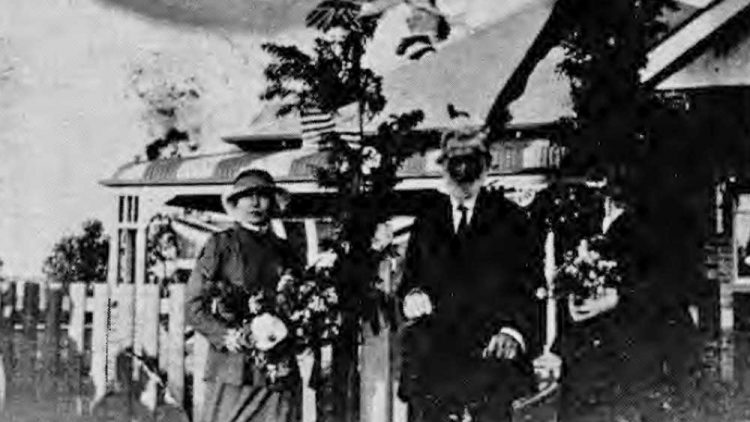
Sister Scahill with her mother, Theresa Scahill, and her grandfather, Mr H. Kelly, in front of her home in Henry Street, Punchbowl at her homecoming from World War I (Courtesy Mrs E.D. Cash)
After the war
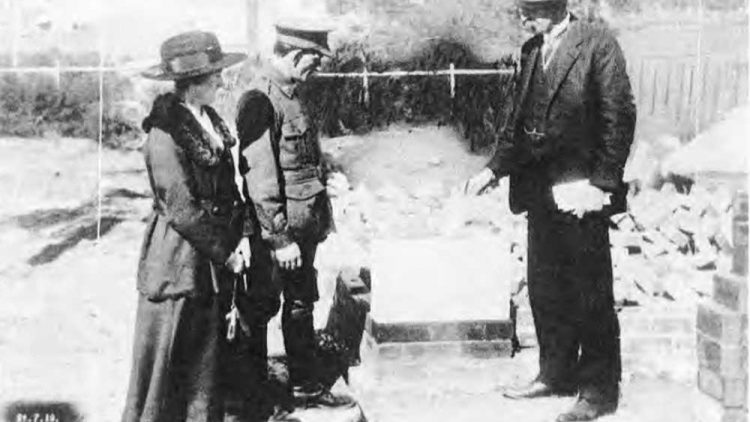
Private and Mrs Baxter watch the laying of the foundation stone by the Governor of the Commonwealth Bank of Australia of the first War Service Home in Australia at 32 Kennedy Avenue, Belmore on 21st July 1919. The stone was removed during renovations by a later owner in 1994. (Courtesy Commonwealth Department of Veterans’ Affairs)
Canterbury Municipality after the war was a popular area in which many War Service Homes and private houses were built, with the population rising from 37,639 at the 1921 Census to 79,050 in 1933 and 99,396 in 1947. In fact, Canterbury was the fastest growing area in Sydney in the inter-war period.
The War Service Homes Scheme was set up to assist servicemen settle in their own homes after the war. The first home in Australia completed under the scheme was at 32 Kennedy Avenue Belmore, for Private Frederick Baxter in 1919.
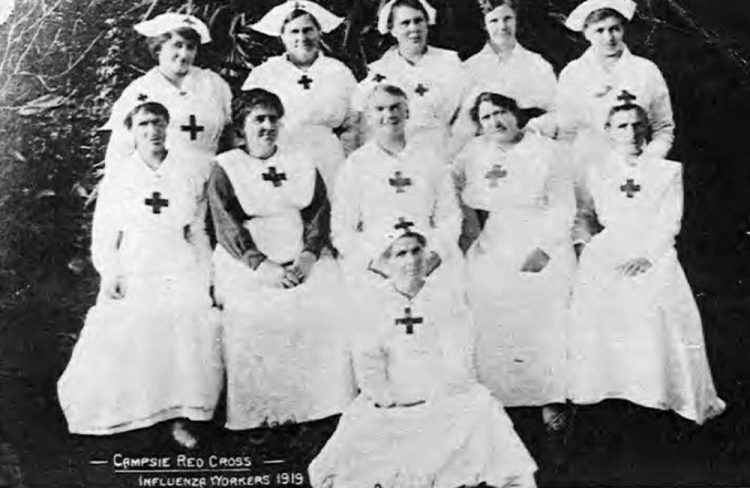
Campsie Red Cross influenza workers, 1919. Top row, second from left, Mrs Ingham, centre, Mrs Burdette. Seated, far left, Mrs Attenborough, second from right, Mrs Harding, far right, Mrs Guttridge. Centre, on ground, Mrs Bradney. (Canterbury City Library)
Part of the land subdivided after the opening of the Goods Line was the site of a complete estate of homes, and one of its streets, Wattle Street, was renamed “Bazentin Street”, after a village near Pozieres in France. In Earlwood, a large estate owned by the War Service Homes Commission has streets named after World War I battle sites in France.
Canterbury’s War Service Homes are significant heritage items. They were mostly architect-designed, and represented the latest ideas of the time on ideal housing for a family. Many variations of houses built to the standard War Service Home plans exist today in estates at Belfield, South Belmore, Lakemba and Clemton Park, and isolated houses can be found throughout the Municipality.
The Commonwealth Government provided Commemorative Medals for every child under 16 years on Armistice Day, and these were distributed by school principals. Young children not attending school received the medals through Canterbury Council.
The influenza epidemic in 1919 required many volunteers to assist the Red Cross and other groups to fight the “dread scourge” and “this fearful disease”, to use the words of the Mayor in his annual report to Council He said: “At the risk of their lives, many endeavoured to act up to the truest traditions of our Nation, by providing food and assistance to those who were unhappily unable to help themselves.”
Returned Soldiers’ organisations
Returned soldiers gathered together to assist each other and the wives and children of comrades who had been killed or severely wounded, and for social activities. Local groups were active in the Canterbury district, such as the Hurlstone Park Soldiers and Sailors Welfare Association, before the war ended.
By September 1920, Sub-Branches of the Returned Soldiers and Sailors Imperial League had been established in Belmore, Campsie and Punchbowl-Lakemba. The Punchbowl-Lakemba Sub-Branch held its second Annual General Meeting in January 1921.
In April 1921, Campsie Sub-Branch was concerned about “the distressful condition” of Mrs E Haydon of Canterbury, widow of the late Sergeant Haydon, and sought help to ameliorate the conditions under which she was endeavouring to exist. A collection at the meeting of £2/0/6 was sent to her as some small help in her need. The report in “The Soldier” noted: “The League may not be necessary to ‘you’ but it is to widows and dependents”. A month later at “the best Smoko we have been at yet”, a further sum of £11 was collected for Mrs Haydon and a committee was appointed to arrange a benefit concert for her. Sergeant John William Haydon, of Bungendore, had enlisted in the 6th Light Horse in September 1914 and returned to Australia the following year, presumably after being wounded at Gallipoli.
Memorials to the soldiers
In October 1915, the Independent Order of Rechabites, Campsie, erected a memorial fountain in Anglo Road, Campsie, to “honour the Fallen Heroes of Canterbury District”.
On Saturday 2nd September 1916, a large crowd gathered for the dedication of Anzac Square (previously Elgin Square) in Campsie as a monument to the deeds of Australian soldiers. A tablet was unveiled on the band rotunda at the entrance to the Square with the following words “Anzac Square. Dedicated to the memory of Canterbury’s sons who at their country’s call fought and fell in the defence of freedom and liberty in the Great War. Greater love hath no man than this that a man lay down his life for his friends”.

The 1915 memorial fountain in Anglo Road, Campsie. (Canterbury City Library)
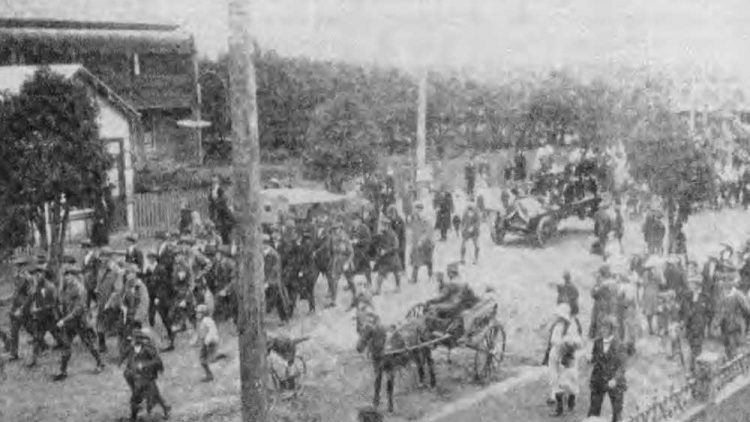
An Anzac Day march about 1919 passing Benjamin Taylor’s two-storey house, “Lakemba”, in Haldon Street, Lakemba. (Canterbury City Library)
A “Memory” Avenue in Canterbury Park was proposed by Canterbury Progress Association, with relatives of those who had fallen at the front planting trees, a nameplate of the person for whose memory it was planted being attached and care being the responsibility of those who planted them The opening ceremony and memorial service took place on 4th August 1918.
On 20 September 1919, an Honour Roll with the names of 88 scholars from the school who had served was unveiled at Belmore North Public School. This Honour Roll cannot be found now. The Soldiers Memorial was unveiled at Punchbowl on 20th December 1919, and War Memorials were unveiled in other suburbs.
Thousands of people were present in Anzac Square, Campsie, on 24th May 1920 when the Governor of NSW unveiled a captured German field gun, one of the War Trophies provided to cities and towns around the nation. The gun was captured by the 3rd Infantry Battalion near Hargicourt on 17th September 1918. The gathering remained silent for two minutes in memory of the dead. The gun and the 1915 memorial fountain was removed in the early 1950s. Their fate is not known but one suggestion is that the gun was used as fill at Campbell Oval, and another that it found its way to a scrap metal dealer.
The foundation stone of the Hurlstone Park War Memorial was laid in September 1920. This was at the railway station but it was moved to Euston Road after World War II because of growth in traffic. The citizens of the district had decided to erect the memorial to bear the names of the thirty citizen soldiers who died during the war, of the 160 men from Hurlstone Park who served.
The Campsie Women’s Strong Post erected the Clock Tower Memorial in Campsie in 1932. Fund- raising had commenced ten years before, but securing a suitable site was more difficult and protracted than raising the money. The present site was the one originally suggested, but a later proposal was to have it at the intersection of Beamish Street and Canterbury Road. The Ladies Committee rejected the actual site at the intersection suggested by the Main Roads Board and finally the Council agreed to Anzac Square.
The Dawn Service was instigated by five Lakemba ex-servicemen. Returning home late from a Smoko, they went to the Cenotaph in Martin Place early on Anzac morning in 1927 – the Cenotaph must have been incomplete because it was not dedicated until 8 August 1927. They saw a woman on her knees holding a bouquet of flowers and weeping silently. They knelt and prayed with her. Remembering their own experiences of dawn attacks and the deaths which followed, they decided that they would return each Anzac dawn to remember their mates. The next year, they suggested to the Association of Returned Sailors and Soldiers Clubs that a wreath be laid on the Cenotaph on 25th April 1928 at dawn, the time of the Gallipoli landing in 1915. From these two happenings grew the annual Dawn Service.
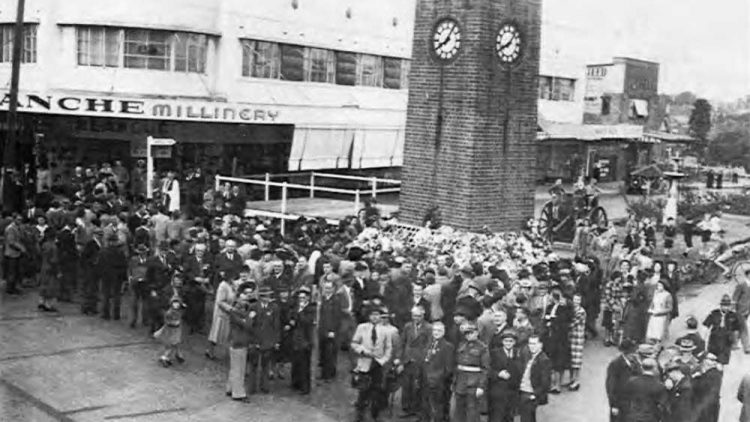
The Clock Tower Memorial before remodelling, the German field gun captured by the 3rd Battalion in 1918 at Hargicourt, and the 1915 memorial fountain are still in place in this 1947 Anzac Day photograph. (Courtesy Dennis Jeans)
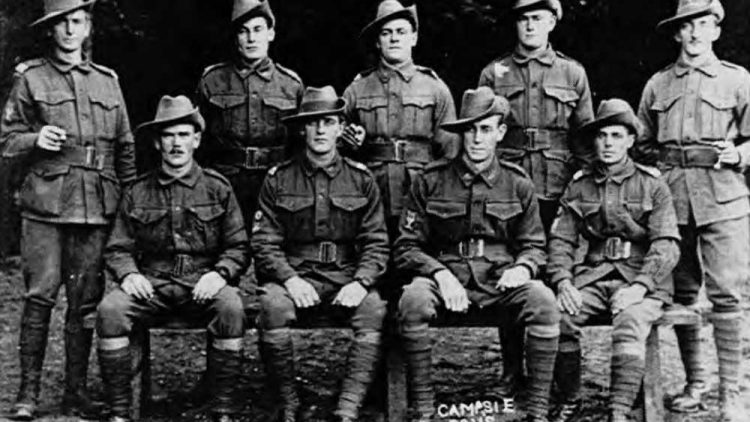
“Campsie Boys”. Cecil Crockford (centre back) and Albert Crockford (to his right) photographed with their mates from Campsie at Amesbury Camp, England, 14th August 1916 (Courtesy Joyce Ormsby)


